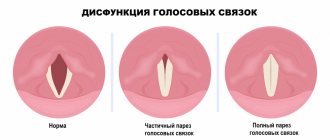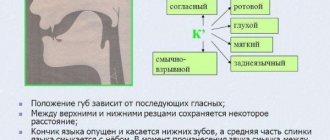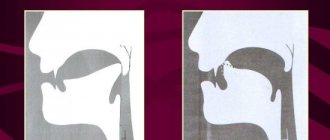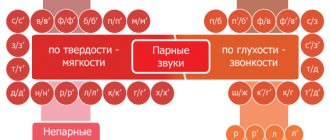Restorative learning for different forms of aphasia
The article discusses the program, specific steps and methods of remedial training for the following forms of aphasia: efferent motor aphasia, dynamic aphasia, afferent motor, sensory, acoustic-mnestic, semantic and amnestic aphasia.
Depending on the form of aphasia, the severity of the defect, the stage of the disease, and the individual characteristics of speech disorders, the integrated use of the considered methods for restoring oral and written speech will help a person adapt to life with this acquired disorder. Restorative learning is based on one of the most important properties of the brain—the ability to compensate. To restore impaired functions, both direct and bypass compensatory mechanisms are used.
Direct disinhibitory methods of work are mainly used in the individual stage of the disease and are designed to activate reserve intrafunctional capabilities. Bypass methods imply compensation based on the restructuring of the most impaired function due to cross-functional restructuring. In other words, the restorative effect is achieved through the introduction of new, “workaround” ways of performing certain speech or gnostic-praxic operations.
It is also necessary to strictly take into account the characteristics of each specific case of the disease.
Rehabilitation training is carried out according to a special, pre-developed program. The program should include certain tasks and corresponding work methods, differentiated depending on the form of aphasia (apraxia, agnosia), severity of the defect, stage of the disease, individual characteristics of speech disorders, but rehabilitation work in it should be carried out on all aspects of the impaired function, and not only over those who suffered primarily.
In addition, rehabilitation training should primarily be aimed at restoring the communication abilities of patients. It is necessary to involve the patient in communication not only in classes, but also in the family, as well as in public places.
Treat or cure?
For any type of aphasia, the cause of the disease is treated first. This is done by neurologists in a hospital setting, since the situations that led to loss of speech threaten the health and sometimes the life of the child. Correction of speech disorders begins at the beginning of the recovery period, when the baby is out of danger. It is necessary to start such classes as early as possible, but not earlier than the attending physician allows it.
The Neurospectr Center for Children's Speech Neurology and Rehabilitation offers a comprehensive approach to rehabilitation for various forms of motor aphasia. In children, this disease has a favorable prognosis: as a rule, speech can be restored in full.
Our center’s specialists have the necessary qualifications to monitor patients in the early recovery period. Experienced neurologists continued the treatment prescribed in the hospital and will adjust it as the condition improves. Doctors, together with speech therapists, will accurately establish a diagnosis and develop a plan of correctional work that takes into account both motor aphasia and related problems that require rehabilitation. Working with a psychologist will help overcome the stress associated with the inability to communicate as usual. A speech therapist and psychologist will help the child establish contact with parents if there are difficulties with this.
An integrated approach allows you to correct several violations at the same time. This happens quite often: in case of poisoning, infections, severe traumatic brain injuries, there may be several lesions. In such cases, in addition to speech therapy, other types of correction may be required. We work with impaired motor activity, with increased excitability and hyperactivity, which appeared after damage to the nervous system or existed before. The center has all the necessary equipment; our doctors, speech pathologists and rehabilitation specialists have extensive experience in working with complex disorders. Taking into account the nature and needs of young patients, we will do everything to achieve the best possible result as soon as possible.
MOTOR APHASIA OF AFFERENT TYPE
Stage of severe disorders
1. Overcoming disorders of understanding situational and everyday speech:
- display of pictures and real images of the most commonly used objects and simple actions by their names, categorical and other characteristics. For example: “Show a table, a cup, a dog, etc.”, “Show pieces of furniture, clothing, transport, etc.” “Show someone who flies, who talks, who sings, who has a tail, etc.”
— classification of words by topic (for example: “Clothing”, “Furniture”, etc.) based on a subject picture;
— answers with an affirmative or negative gesture to simple situational questions. For example, “Is it winter now, summer..?”; "You live in Moscow?" and etc.
2. Disinhibition of the pronunciation side of speech:
- conjugate, reflected and independent pronunciation of automated speech series (ordinal counting, days of the week, months in order, singing with words, ending proverbs and phrases with a “hard” context), modeling situations that stimulate the pronunciation of onomatopoeic pronouns (“ah!” “oh” !" and so on.);
- conjugate and reflected pronunciation of simple words and phrases;
- inhibition of the speech embolus by introducing it into a word (ta, ta..-Tata, so), or into a phrase (ma..ma-mama...; this is mom).
3. Stimulating simple communicative types of speech:
— answers to questions in one or two words in a simple situational dialogue;
— modeling situations that contribute to the evocation of communicatively significant words (yes, no, want, will, etc.);
— answers to situational questions and composing simple phrases using a pictogram and a gesture accompanied by the pronunciation of simple words and phrases.
4. Stimulating global reading and writing:
— laying out captions under pictures (subject and subject);
- writing the most common words-ideograms, copying simple texts;
— conjugate reading of simple dialogues.
Moderate stage of disorders
1. Overcoming disorders of the pronunciation side of speech:
- isolating sounds from words;
— automation of individual articles in words with different syllabic structures;
— overcoming literal paraphasias by selecting first discrete and then gradually converging sounds in articulation.
2. Restoration and correction of phrasal speech:
- composing phrases based on a plot picture: from simple models (subject-predicate, subject-predicate-object) to more complex ones, including objects with prepositions, negative words, etc.;
- composing phrases on questions, on key words;
- exteriorization of grammatical-semantic connections of the predicate: “who?”, “why?”, “when?”, “where?” etc.;
— filling in gaps in a phrase with a grammatical change in a word;
— detailed answers to questions;
- compiling stories based on a series of plot pictures;
- retelling texts based on questions.
3. Work on the semantics of the word:
— development of generalized concepts;
- semantic play on words (subject and verbal vocabulary) by including them in various semantic contexts;
— filling in the gaps in a phrase;
- completing sentences with different words that are appropriate in meaning;
- selection of antonyms, synonyms.
4. Restoration of analytical-synthetic writing and reading:
- the sound-letter composition of the word, its analysis (one-two-three-syllable words) based on diagrams that convey the syllabic and sound-letter structure of the word, a gradual reduction in the number of external supports;
- filling in missing letters and syllables in words;
- copying words, phrases and small texts with an emphasis on self-control and independent error correction;>
- reading and writing from dictation of words with a gradually more complex sound structure, simple phrases, as well as individual syllables and letters;
- filling in missing words in texts when reading and writing, practiced in oral speech.
Stage of mild disorders
1. Further correction of the pronunciation aspect of speech:
— clarification with articles of individual sounds, especially affricates and diphthongs;
— differentiation of acoustic and kinesthetic images that are similar in articulation of sounds in order to eliminate literal paraphasias;
- practicing the purity of pronunciation of individual sounds in a sound stream, in phrases, with a combination of consonant sounds, in tongue twisters, etc.
2. Formation of detailed speech, complicated in semantic and syntactic structure:
- filling in the missing main sentence, as well as a subordinate sentence or subordinating conjunction in a complex sentence;
- answering questions with complex sentences;
- retelling texts without relying on questions;
— drawing up detailed plans for texts;
— preparation of thematic messages (short reports);
- speech improvisations on a given topic.
3. Further work to restore the semantic structure of the word:
- interpretation of individual words, mainly with abstract meaning;
— explanation of homonyms, metaphors, proverbs, phraseological units.
4. Work on understanding complex logical and grammatical figures of speech:
— execution of instructions, including logical and grammatical phrases;
— introduction of additional words, pictures, questions that facilitate the perception of complex speech structures.
5. Further restoration of reading and writing:
- reading and retelling expanded texts;
- dictations;
— written presentation of texts;
— writing letters, greeting cards, etc.;
- essays on a given topic.
1) Restoring the “articuleme-phoneme” connection
- writing letters corresponding to the names of sounds in expressive speech, reading these letters immediately after writing;
- isolating the first sound from simple words, fixing attention on the articulatory, acoustic, and then graphic image of this sound; independent selection of words for this sound and writing them;
- writing practiced sounds and syllables under dictation;
— identification of letters in different fonts;
— finding given letters in various texts (underlining, writing out).
2) Restoring the ability to sound-letter analysis of the composition of a word:
- dividing words into syllables, syllables into letters (sounds) based on various graphic schemes;
- highlighting any sound in a word;
- recalculation and listing of words by letter (orally);
- filling in gaps in words;
- writing words from letters given separately.
3) Restoring the skill of detailed written speech:
- writing words of different sound structures with and without support from an object picture: a) under dictation, b) when naming an object or action;
- writing proposals: a) from memory, b) from dictation, c) in the form of a written statement based on a plot picture for the purpose of communication with others;
- written statements and essays.
MOTOR APHASIA OF EFFERENT TYPE
Stage of severe disorders
The recovery program is the same as for afferent motor aphasia.
Moderate stage of disorders
1. Overcoming disorders of the pronunciation side of speech:
- development of articulatory switches within a syllable:
with vowels contrasting in articulation pattern (“a” – “u”, etc.); with various vowels, including soft ones; in syllables, for example,
M A A S T R E C E P T
- development of articulatory switching within a word: merging syllables into words with a simple, and later with a complex sound structure (for example, recipe, etc.);
- exteriorization of the sound-rhythmic side of the word, dividing words into syllables, highlighting the stress in the word, reproducing the outline of the word in the voice, selecting words with an identical sound-rhythmic structure, rhythmic pronunciation of words and phrases with the use of external supports - tapping, clapping, etc. , capturing various consonances, including the selection of rhyming words.
2. Restoration of phrasal speech:
— overcoming agrammatism at the level of the syntactic scheme of a phrase: composing “core” phrases of models like S (subject) + P (predicate); S+P+O (object) with the involvement of external supports-chips and their gradual “collapse”; highlighting the predicative center of the phrase; exteriorization of its semantic connections;
— overcoming agrammatism at the formal grammatical level: catching grammatical distortions—inflectional, prepositional, etc. in order to revive the sense of language; differentiation of singular and plural meanings, generic meanings, meanings of the present, past and future tenses of the verb; filling in missing grammatical elements in words; composing phrases based on plot pictures; answering questions with a simple phrase, grammatically formatted; retelling a simple text; stimulation to use incentive and interrogative sentences, various prepositional structures.
Stage of mild disorders
The program is the same as for the corresponding stage of afferent motor aphasia.
When restoring written speech in patients with motor aphasia of the efferent type, as a rule, the independent task of developing the “articulome-grapheme” connection is not highlighted.
The emphasis is on:
1. Restoring the ability to analyze the sound-rhythmic side of a word:
— differentiation of words by length and syllabic composition;
- highlighting the stressed syllable;
- selection of words identical in sound-rhythmic structure;
- highlighting identical elements in words - syllables, morphemes and, in particular, endings (underlining them, writing them out, etc.).
2. Restoring the ability to sound-letter analysis of the composition of a word.
3. Restoring the skill of merging letters into syllables, syllables into words.
4. Restoring the skill of detailed written speech (specific teaching methods - see the program for restoring learning for afferent motor aphasia - paragraphs 2,3,4).
Manifestations of the disease
The group of symptoms that manifests itself to a greater extent depends on which area of the brain is affected when sensory aphasia occurs. In any case, this is Wernicke’s area, where the speech analyzer is located, but the specific characteristics of sensory aphasia depend on whether the left or right hemisphere is affected: the perception or reproduction of speech is more impaired.
For a patient with sensory aphasia, words are just a collection of sounds. In some cases, recognition is partially preserved: the patient can identify the object shown to him as living or non-living, large or small. But he is unable to name the object itself. At the same time, the patient, as a rule, can perform simple actions on command - stand up, raise his hand, turn around. Without treatment, the disease progresses and leads to a complete misunderstanding of what is being said. Your own words are also not perceived as speech. Due to the lack of control by hearing, words become incoherent and are pronounced incorrectly and sometimes unrecognizable. Intonation also suffers. Pronunciation may be restored, but the construction of phrases will not appear on its own. Patients try to talk, and get angry when those around them do not understand them: a patient with sensory aphasia is sure that he speaks clearly.
Writing is also impaired to the same extent as speech. But the ability to read is lost only slightly - mainly due to confused stresses that distort the meaning of words.
DYNAMIC APHASAIA
Stage of severe disorders
1. Increasing the level of general activity of the patient, overcoming speech inactivity, organizing voluntary attention:
- performing various types of non-verbal activities (drawing, modeling, etc.);
— assessment of distorted images, words, phrases, etc.;
- situational, emotionally significant dialogue for the patient;
- listening to plot texts and answering questions about them in the form of affirmative-negative gestures or words “yes”, “no”.
2. Stimulating simple types of communicative speech:
— automation in dialogical speech of communicatively significant words: “yes”, “no”, “can”, “want”, “will”, “must”, etc.;
— automation of individual cliches of communicative, incentive and interrogative speech: “give”, “come here”, “who’s there?”, “hush!” etc.
3. Overcoming speech programming disorders:
- stimulation of answers to questions with a gradual decrease in the answer of words borrowed from the question;
- constructing phrases of the simplest syntactic models based on chips and a simple plot picture;
- performing simple grammatical transformations to change words that make up a phrase, but are presented in nominative forms;
- laying out a series of sequential pictures according to the plot contained in them.
4. Overcoming grammatical structuring disorders
5. Stimulating written speech:
— laying out captions under pictures;
- reading ideogram words and phrases.
Moderate stage of disorders
1. Restoration of communicative phrasal speech:
— construction of a simple phrase;
- composing phrases based on a plot picture using the chip method and gradually “collapsing” the number of external supports;
- compiling a story based on a series of sequential pictures;
— detailed answers to questions in the dialogue;
- compiling simple dialogues like speech sketches: “In a store” - a dialogue between a buyer and a seller, “In a savings bank”, “In an atelier”, etc.
2. Overcoming perseverations in independent oral and written statements:
- display of objects in pictures and in the room, parts of the body (in random order, by individual names and by series of names);
- ending phrases with different words;
- selection of words of given categories and in given quantities, for example, two words related to the topic “Clothing” and one word related to the topic “Tableware”, etc.;
- writing numbers and letters broken down (from dictation);
- writing from dictation of words and phrases that contribute to the development of semantic and motor switching;
— elements of sound-letter analysis of the composition of a word: folding simple words from letters of a split alphabet;
- filling in gaps in words;
- writing simple words from memory and dictation.
Stage of mild disorders
1. Restoration of spontaneous communicative phrasal speech:
- extensive dialogue on various topics;
- constructing phrases based on a plot picture with a gradual decrease in the number of external supports;
— automation of phrases of certain syntactic models in spontaneous speech;
- accumulation of a verbal dictionary and “revitalization” of the semantic connections behind the predicate (with the help of questions posed to it);
- reading and retelling texts;
- “role-playing conversations”, playing out a certain situation;
- “speech improvisations” on a given topic;
- detailed presentations of texts, essays;
- drafting greeting cards, letters, etc.
Tests to determine left-handedness or right-handedness (right-handedness/left-handedness)
Determine the dominant eye. The patient is asked to look through a kaleidoscope or telescope (to which eye he brings the left or right one first).- Interlocking of fingers: upper position of the thumb (left, right).
- Cross your arms over your chest: “Napoleon pose”, which hand is on top - left, right.
- Determination of the size of the thumb nail.
- On which arm (left, right) is the venous system more developed?
- Determine which hand is 1-2 mm longer.
- Observe which leg is dominant in the sport.
- Which hand holds a pen, fork, spoon, brushes teeth, shoes.
- Which hand combs the hair, which side is the parting on the head.
- Which hand washes, digs, screws, cuts paper, cuts nails, unlocks a door, hammers nails, saws, etc.
- Which hand is more comfortable to play a musical instrument?
The patient's closest relatives should answer these questions to the doctor. The test can determine not only the leading hand (more than half of the answers), but also hidden left-handedness, if a left-handed type of reaction is detected in three or more questions.
Usually in left-handed aphasics
the prospects for speech restoration are better than for right-handers, since the functions of the right hemisphere remain largely intact. When the parietal and temporal lobes of the left hemisphere are damaged, speech restoration occurs based on the planning function of the frontal lobe of the left hemisphere, which allows the patient to gain motivation to learn. Difficulties in restoring speech in left-handers arise only with acoustic-mnestic and semantic aphasia. In left-handed people, dynamic aphasia practically does not manifest itself due to the high interchangeability of the functions of the posterior frontal parts of the brain.
Up
SENSORY APHASIA
Stage of severe disorders
1. Accumulation of everyday passive vocabulary:
— display of pictures depicting objects and actions by their names, functional, classification and other characteristics
— display of pictures depicting objects belonging to certain categories (“clothing”, “dishes”, “furniture”, etc.);
- showing body parts in the picture and in yourself;
- choosing the correct name of the object and action among the correct and conflicting designations based on the picture.
2. Stimulation of understanding of situational phrasal speech:
- answering questions with words “yes”, “no”, affirmative or negative gesture;>
- following simple oral instructions;
— capturing semantic distortions in simple phrases deformed in meaning.
3. Preparation for restoration of written speech:
— laying out captions for subject and simple plot pictures;
— answers to questions in a simple dialogue based on visual perception of the text of the question and answer;
- writing words, syllables and letters from memory;
- “voiced reading” of individual letters, syllables and words (the patient reads “to himself”, and the teacher reads out loud);
- development of the “phoneme-grapheme” connection by selecting a given letter and syllable by name, writing letters and syllables under dictation.
Moderate stage of disorders
1. Restoration of phonemic hearing:
- differentiation of words that differ in length and rhythmic structure;
- highlighting the same 1st sound in words of different lengths and rhythmic structures, for example: “house”, “sofa”, etc.;
- highlighting different 1st sounds in words with the same rhythmic structure, for example, “work”, “care”, “gate”, etc.;
- differentiation of words that are similar in length and rhythmic structure with disjunctive and oppositional phonemes by identifying differentiated phonemes, filling in gaps in words and phrases; capturing semantic distortions in a phrase; answers to questions containing words with oppositional phonemes; reading texts with these words.
2. Restoring understanding of the meaning of a word:
— development of generalized concepts by classifying words into categories; selection of a generalizing word for groups of words belonging to one or another category;
— filling in gaps in phrases;
- selection of definitions for words.
3. Overcoming oral speech disorders:
— “imposing a framework” on a statement by composing sentences from a given number of words (instructions: “Make a sentence of 3 words!”, etc.);
— clarification of the lexical and phonetic composition of the phrase using the analysis of verbal and literal paraphasias admitted by the patient;
— elimination of elements of agrammatism using exercises to “revitalize” the sense of language, as well as analysis of grammatical distortions.
4. Restoration of written speech:
- strengthening the “phoneme-grapheme” connection by reading and writing letters under dictation;
— various types of sound-letter analysis of the composition of a word with a gradual “collapse” of external supports;
- writing from dictation of words and simple phrases;
- reading words and phrases, as well as simple texts, followed by answers to questions;
- independent writing of words and phrases from pictures or written dialogue.
Stage of mild disorders
1. Restoring understanding of extended speech:
— answers to questions in an expanded, non-situational dialogue;
- listening to texts and answering questions about them;
— capturing distortions in deformed compound and complex sentences;
— understanding of logical and grammatical figures of speech;
— implementation of oral instructions in the form of logical and grammatical figures of speech.
2. Further work to restore the semantic structure of the word:
- selection of synonyms as homogeneous members of a sentence and out of context;
- work on homonyms, antonyms, phraseological units.
3. Correction of oral speech:
— restoration of the self-control function by fixing the patient’s attention on his mistakes;
- compiling stories based on a series of plot pictures;
- retelling texts according to plan and without plan;
— drawing up plans for texts;
- composing speech improvisations on a given topic;
— speech sketches with elements of “role-playing games”.
4. Further restoration of reading and writing:
— reading expanded texts, various fonts;
- dictations;
- written statements;
- written essays;
- mastering samples of congratulatory letters, business notes, etc.
There are four main types of post-stroke speech disorders
Damage to the language center in the dominant hemisphere - Broca's area - leads to the fact that patients lose the ability to convey their thoughts using coherent and grammatically correct language structures. Conversely, pathological changes in Wernicke's area (sensory center) lead to problems in receptivity to language. Such patients have difficulty understanding spoken or written language. They often use correct grammatical structures, but their statements may not make sense. The most severe form of aphasia (global or total) occurs in patients with extensive damage to several areas of the brain responsible for understanding and language. The mildest form of aphasia—amnestic—leads to difficulty working with vocabulary.
How do these types of aphasia manifest themselves in practice?
Damage to the language center in the dominant hemisphere - Broca's area - leads to the fact that patients lose the ability to convey their thoughts using coherent and grammatically correct language structures. Conversely, pathological changes in Wernicke's area (sensory center) lead to problems in receptivity to language. These patients have difficulty understanding spoken or written language. They often use correct grammatical structures, but their statements may not make sense. The most severe form of aphasia (global or total) occurs in patients with extensive damage to several areas of the brain responsible for understanding and language. The mildest form of aphasia—amnestic—leads to difficulty working with vocabulary.
How do these types of aphasia manifest themselves in practice?
- Motor aphasia. You know what you want to say, but you can’t find (remember, use and pronounce) the right words.
- Sensory aphasia. You hear someone speak or see printed text, but cannot understand the meaning of the words.
- Amnestic aphasia. You find it difficult to select and use the correct words to refer to certain people, objects, places or events.
- Global aphasia. You cannot speak, write, read and do not understand what is being said to you.
ACOUSTIC-MNESTIC APHASIA
Stage of disorders of moderate and mild severity
1. Expanding the scope of auditory perception:
— display of objects (real and in pictures) by name, presented in pairs, triplets, etc.;
- showing body parts according to the same principle;
— implementation of 2-3-level oral instructions;
— answers to detailed questions, complicated by syntactic structure;
- listening to texts consisting of several sentences and answering questions about the content of the texts;
- writing from dictation with a gradual increase in phrases;
- reading gradually increasing phrases, followed by reproduction (from memory) of each of the sentences and the entire set as a whole.
2. Overcoming weakness of auditory-speech traces:
- repetition from memory of read letters, words, phrases with a gradual increase in the time interval between reading and reproduction, as well as filling the pause with some other type of activity;
— memorizing short poems and prose texts;
— repeated display of objects and pictures after 5-10 seconds, after 1 minute. after the first presentation;
- reading texts with time-delayed retelling (after 10 minutes, 30 minutes, the next day, etc.);
- composing orally sentences using reference words perceived visually;
- listing words by letter with a gradually more complex sound structure, and gradually moving away from the written example of these words.
3. Overcoming naming difficulties:
- analysis of visual images and independent drawing of objects denoted by name words;
- semantic play in contexts of various types of words denoting objects, actions and attributes of objects;
— classification of words with independent finding of a generalizing word;
— exercises on the interpretation of words with concrete, abstract and figurative meaning.
4. Organization of a detailed statement:
- compiling a story based on a series of plot pictures;
- retelling of texts, first according to a detailed plan, then according to a condensed plan, then without a plan;
- extensive dialogues on non-situational topics (professional, social, etc.); practicing samples of communicative and narrative writing (greeting cards, letters, statements, essays on a given topic, etc.).
SEMANTIC APHASIA
Stage of disorders of moderate and mild severity
1. Overcoming spatial apractognosia:
— a schematic representation of the spatial relationships of objects;
- image of the plan of the path, room, etc.;
- design according to a model, according to a verbal task;
— work with a geographical map, hours.
2. Restoring the ability to understand words with spatial meaning (prepositions, adverbs, verbs with “movement” prefixes, etc.):
— a visual representation of simple spatial situations denoted by prepositions and other parts of speech;
— filling in missing “spatial” elements in words and phrases;
- composing phrases with words that have spatial
3. Construction of complex sentences:
— clarification of the meanings of subordinating conjunctions;
— filling in missing main and subordinate clauses;
- composing sentences with given conjunctions.
4. Restoring the ability to understand logical and grammatical situations:
- a picture depiction of the plot of the structure;
- the introduction of additional words that provide semantic redundancy (“my brother’s father”, “a letter from a beloved friend”, etc.);
— introduction of logical-grammatical constructions into a detailed semantic context;
- presenting designs in writing and then orally.
5. Work on an extended statement:
- presentations, essays;
— improvisation on a given topic;
- interpretation of words with complex semantic structure...
Article from the site: wapref.ru/referat_qasyfsujgpolyfsaty.html









